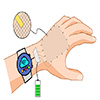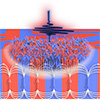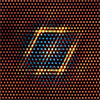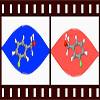Mar 28, 2025 Artificial cells using riboswitch-gene fusion in liposomes produce fluorescent proteins when detecting specific targets. Multiple cell types can simultaneously detect different targets.RetryClaude can make mistakes. Please double-check responses. (Nanowerk News) Researchers from Ehime University created novel artificial cells by encapsulating a riboswitch-gene fusion with wheat germ extract...
Meet the miniature rolling robot that takes virtual biopsies from inside your body
Mar 28, 2025 Researchers have developed a tiny magnetic robot that can take 3D scans from deep within the body and could revolutionize early cancer detection. (Nanowerk News) Researchers have developed a tiny magnetic robot that can take 3D scans from deep within the body and could revolutionise early cancer...
A lighter, smarter magnetoreceptive electronic skin
Mar 27, 2025 Novel e-skins unlock a new level of interaction between humans and machines. (Nanowerk News) Imagine navigating a virtual reality with contact lenses or operating your smartphone under water: This and more could soon be a reality thanks to innovative e-skins. A research team led by the Helmholtz-Zentrum...
Van der Waals integration of graphene and GaN enables next-generation electronics
Mar 27, 2025 (Nanowerk Spotlight) Advances in semiconductor technology have reached a critical turning point. Silicon-based transistor technology, central to electronics, faces increasing limitations due to the fundamental quantum properties of silicon at extremely small scales. Moore’s Law, predicting that computing power doubles approximately every two years, is nearing its...
Scientists successfully harness heat to control magnetism in 2D materials
Mar 27, 2025 Pioneering new research could help unlock exciting new potential to create ultrafast, laser-driven storage devices. (Nanowerk News) New research, led by experts from the University of Exeter, would revolutionize the field of data storage, through the development of laser-driven magnetic domain memories. The findings have been published...
Examining how nanoscopic ripples affect material properties
Mar 27, 2025 New research validates theoretical models about how elasticity is scale-dependent - in other words, the elastic properties of a material are not constant, but vary with the size of the piece of material. (Nanowerk News) When materials are created on a nanometer scale — just a handful...
Nanocrystalline copper alloy achieves unprecedented high-temperature performance
Mar 27, 2025 Strongest Cu-Ta-Li alloy to date demonstrates exceptional strength and stability for advanced engineering applications. (Nanowerk News) A team of researchers from Arizona State University, the U.S. Army Research Laboratory (ARL), Lehigh University and Louisiana State University has developed a groundbreaking high-temperature copper alloy with exceptional thermal stability...
A new nanomaterial to make lightsails for interstellar travel
Mar 27, 2025 In a potential step toward sending small spacecraft to the stars, researchers have developed an ultra-thin, ultra-reflective membrane designed to ride a column of laser light to incredible speeds. (Nanowerk News) Since its launch in 1977, NASA’s Voyager 1 spacecraft has traveled over 15 billion miles into...
Researchers control the handedness of molecules
Mar 27, 2025 Experiment is an important step towards isolating right- and lefthanded molecules from each other. (Nanowerk News) A team of DESY researchers, led by DESY lead scientist and University of Kiel professor Melanie Schnell, has managed to control the generation of left- and right-handed organic molecules at the...
DNA microscope creates 3D images of organisms from the inside out
Mar 27, 2025 Researchers develop new technology to create a spatial map of gene expression for an entire organism. (Nanowerk News) Standard genetic sequencing approaches can tell you a lot about the genetic makeup and activity in a sample, like a piece of tissue or drop of blood. But they...










